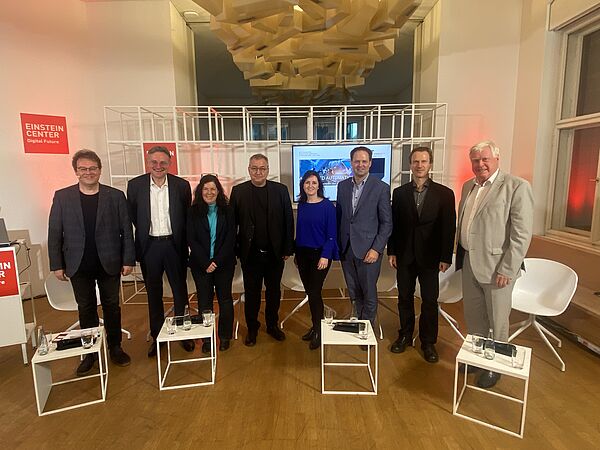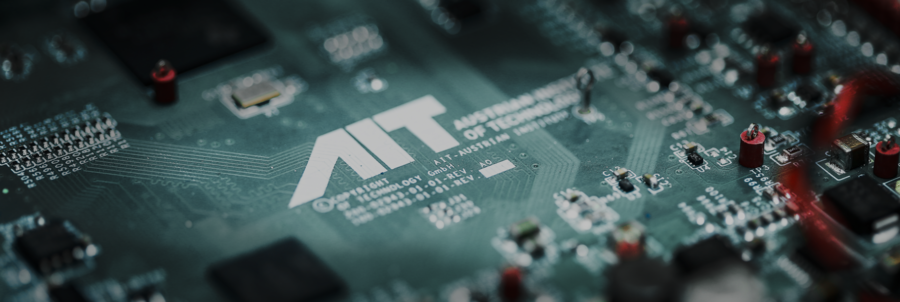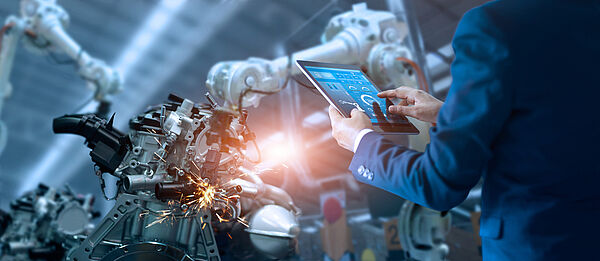Artificial intelligence (AI) is no longer just a topic for the future. Rather, AI methods are penetrating more and more areas of our lives and work. This ranges from useful tools for our everyday lives to applications in healthcare, urban planning and the detection of fake news to speech algorithms and the development of (partially) autonomous vehicles and machines. AI also enables major advances in science and research. What's more, the technology is urgently needed to cope with the accumulation of shocks, crises and upheavals we are currently experiencing.
Autonomous machines and vehicles
A strategic research goal of the AIT Austrian Institute of Technology is the development of (partially) autonomous working machines, such as excavators, cranes, forklifts, etc. These are intended to support humans in their activities and take over heavy, dangerous or monotonous tasks. A test site was recently set up at the Seibersdorf site, for example, where an autonomous loading crane for tree trunks is being developed and tested. The task "Drive to the tree trunk, grab the tree trunk and bring it to the truck!" is a clearly defined and (with the appropriate equipment) easily solvable task for humans. For machines, this has hardly been possible until now. This is because there are many complex tasks and research questions behind the seemingly simple command. This includes, for example, reliable task and motion planning, including localization of the robot's own position - even in changing environments - correct grasping of objects, robust perception of the environment, and object classification for correct interpretation of the environment.
The requirements for robots become even greater when they leave "protected" and well-defined environments such as factory floors or timber loading yards and have to find their way in the real world - with many disruptive and often unpredictable influencing factors that are impossible to take into account all in advance. Safety aspects are particularly problematic: Autonomous machines must never pose a danger to other objects and certainly not to humans. To ensure this, precise knowledge of their environment is necessary.
Precise recognition of the environment
To this end, camera systems, radar and laser measurements, and mathematical methods are used to create a highly accurate 3D model of the environment, which is then segmented in a next step. Individual objects - such as a traffic sign or a pedestrian - are classified and assigned certain properties (e.g., a traffic sign has a fixed location, but pedestrians move around). With the help of machine learning methods, this information can be combined with other information to arrive at an understanding of the scene, on the basis of which decisions can be made.
In autonomous vehicles, this environment recognition is the basis for motion planning and car control. According to Expert:inside, the correct interpretation of the environment model is the weakest link in autonomous driving. Incorrect classification of, for example, an oncoming vehicle or crossing pedestrians can have disastrous consequences - as some famous accidents involving test cars from well-known companies have shown.

Top-class panel discussion at the "Berlin Science Week" on the topic "AI-enabled Automation: How intelligent machines support humans" (from left to right): Martin Kugler (Moderator, AIT), Andreas Kugi (TU Vienna, AIT), Elisabeth André (University of Augsburg), Manfred Tscheligi (University of Salzburg, AIT), Lydia Kaiser (TU Berlin), Johannes Winter (L3S), Matthias Scheutz (Tufts University, AIT) and Wolfgang Knoll (Managing Director AIT).
Cooperation with humans
Intelligent machines of the future are not intended to replace humans, but to support them. The goal is to combine the respective strengths of humans and machines. Intelligent machines can relieve humans of strenuous, dangerous and monotonous work and make production processes more efficient, flexible, sustainable and resilient. Humans can concentrate on more complex, supervisory or creative activities and act in terms of holistic problem solving. Technical processes are consistently aligned with the needs and necessities of people (Human Centered Design).
At the beginning of November, these topics were the focus of a panel discussion organized by AIT as part of the "Berlin Science Week" at the "Einstein Center Digital Future" in Berlin. Under the title "AI-enabled Automation: How Intelligent Machines Support Humans", leading experts contributed their know-how - specifically: Andreas Kugi (TU Vienna, AIT), Lydia Kaiser (TU Berlin), Matthias Scheutz (Tufts University, AIT), Elisabeth André (University of Augsburg), Manfred Tscheligi (University of Salzburg, AIT), and Johannes Winter (L3S).
The panel discussion identified numerous application areas where intelligent machines can help us meet future challenges: for example, increasing productivity and competitiveness, improving quality, conserving resources, avoiding CO2 emissions, or optimizing the use of - increasingly scarce - labor.
The topic of "AI-enabled automation" also takes up a lot of space in this year's Alpbach Technology Symposium 2022 Yearbook, titled "AI in practice / Applying AI". Free download:
https://www.ait.ac.at/fileadmin/cmc/downloads/News/efatec22/TG2022-Book-165x240-SCR.pdf
The entire recording of the debate can be viewed here:



